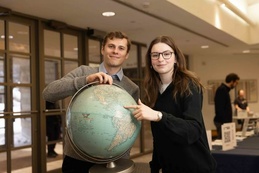Encyclopedias of Women's Contributions
Spectator
By Stephen Tuttle | March 16, 2024
"Women's history is women's right—an essential, indispensable heritage from which we can draw pride, comfort, courage, and long-range vision."
Gerda Lerner, a founding member of the National Organization for Women (NOW) and one of the first to seriously study women’s history as an academic endeavor, said the above some time in the late 1960s. It is no less true now than it was then, and when Women’s History Month was named officially as March in 1987, it was a bit late given that women’s history mirrors all of human history.
This comes to mind as Caitlin Clark, a basketball player for the University of Iowa, creates her own history, laying waste to basketball scoring records for men and women and being criticized for it in the process.
Women have been making discoveries and breaking records for a long time, often unrecognized and uncredited by their male peers or the world at large.
For example, Margaret E. Knight, a prolific 19th century inventor, created a machine in 1867 that cut, glued, and folded paper in a way that resulted in the first flat-bottom paper bags not dissimilar to what still exists today. A machinist, a man who shall remain nameless lest he receive more attention, saw the prototype of Knight’s machine being built, copied the details from memory, and then patented the device himself. When Knight claimed “patent interference,” the man claimed no woman could possibly understand such a complicated machine, much less construct one. Knight, of course, proved otherwise and won her case and her patent in 1871.
Mary Anderson invented the first automobile windshield wipers in 1902, though they had to be operated manually. The automotive industry didn’t see the need for such a device, especially one invented by a woman, and she never profited from her invention, even when a version of it was automated in 1917.
Sometimes the invention was a little quirky. Bette Nesmith Graham invented something many of you reading this will have never seen or used, nor will you immediately recognize her connection to pop culture. Ms. Graham was a typist always looking for a better way to correct inevitable mistakes. In 1956 she invented something called Liquid Paper, a white paint-like substance you could use to cover and type over mistakes. Yes, “type” because there were tools at the time called typewriters…Google them.
(Her connection to pop culture? Ms. Graham’s son Michael Nesmith was the guitarist for a pop band called The Monkees that was reasonably popular, selling 76 million records mostly in the 1960s.)
Women have also been responsible for far less lighthearted inventions.
Stephanie Kwolek, a research scientist at DuPont, helped invent not just one but two life-saving fabrics still in use today. Kwolek was primarily responsible for the creation of bullet-resistant Kevlar in 1965 which is still saving lives, and she was also involved in the creation of fire-resistant Nomex, still in use.
Then there was Hedy Lamarr. A stunning actress during Hollywood’s so-called Golden Age (1927 – 1960 according to Classical Hollywood), Lamarr was also an inveterate tinkerer and inventor. Together with musician George Antheil, Lamarr created something called frequency hopping to prevent military radio signals from being jammed. When the idea was presented to the U.S. military, they suggested Lamarr should instead use her beauty and celebrity to sell War Bonds. The invention, for which Lamarr and Anthiel received multiple patents, would have saved Allied lives in the remainder of World War II. It was the seed that grew into today’s Wi-Fi, Bluetooth, and GPS among many applications.
If you have ever had an x-ray or received any kind of radiation-related diagnostic experience or treatment, you should pause for a moment and acknowledge Marie Curie.
Curie and her husband Pierre discovered polonium and radium and then discovered (and named) radioactivity, for which they received the Nobel Prize in physics in 1903. You’d think that would have been enough, but Marie Curie became one of only two people in history to receive Nobel Prizes in two separate disciplines when she won for chemistry in 1911 after having managed to isolate radium.
Regrettably, the dangers of radiation were not widely understood during Curie’s time. While radiation has saved countless lives in medical applications since, it has also been used to kill and destroy. Curie herself, having worked with radium unprotected for years, died of radiation-induced leukemia in 1934.
We created a Women’s History Month because women’s contributions to our lives and accomplishments in every field of endeavor had been ignored, stolen, or diminished. The above list was literally plucked at random from what could be, and should be, an entire series of encyclopedias of women’s contributions to our daily lives.
Women have their own history month because we’ve never acknowledged their history has been the world’s history from the beginning.
Trending

Michigan’s Marijuana Tax at Work
Cannabis has become a big business in northern Michigan, and local governments are putting tax dollars earned from dispensar… Read More >>
California Sober: Why People Are Switching from Alcohol to Weed
They call it “California sober.” Generally speaking, this term applies to folks who use marijuana but abstain f… Read More >>
The Legacy of Student Activism
“It’s a physical letter to your representative,” Alex Tank says when asked to define the word “prote… Read More >>


